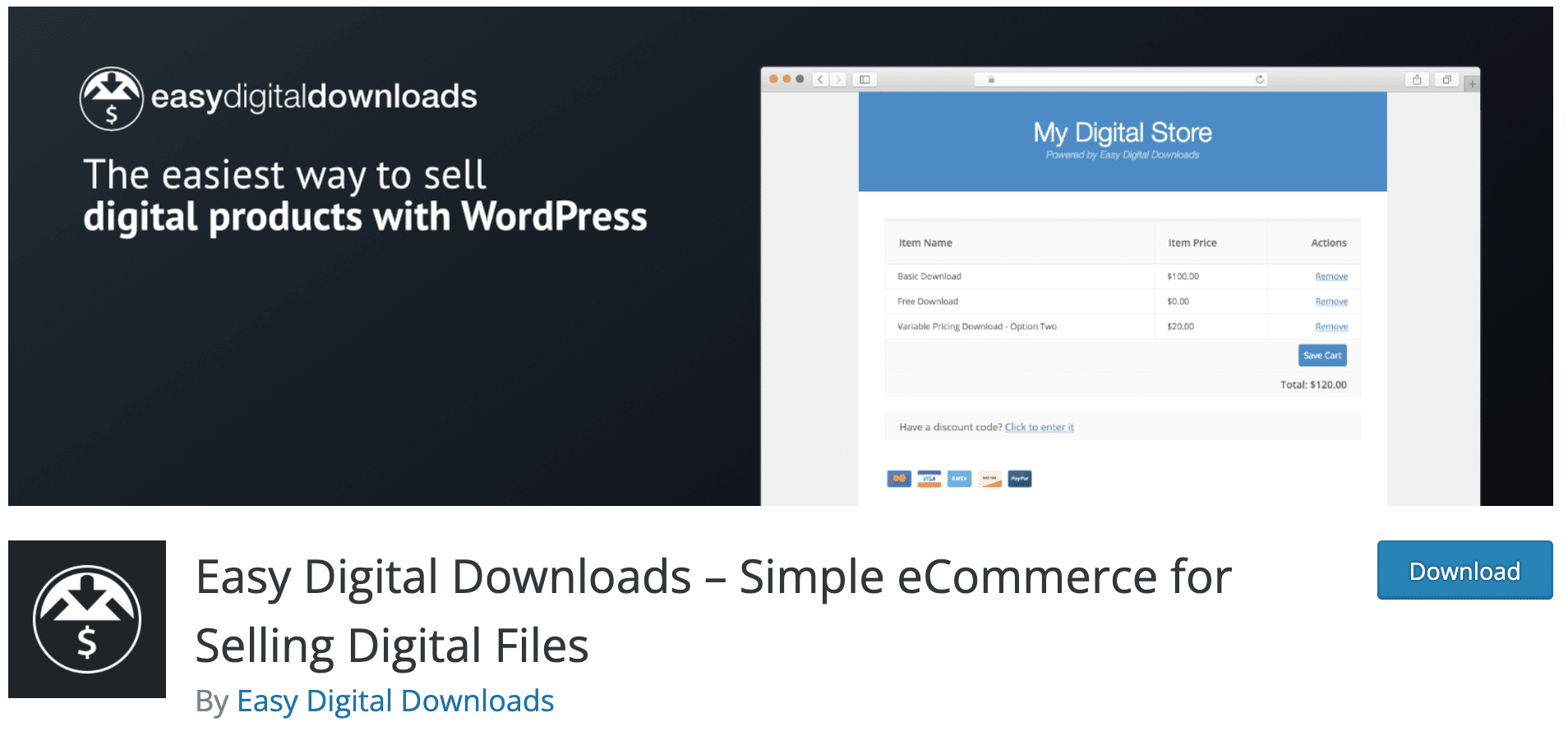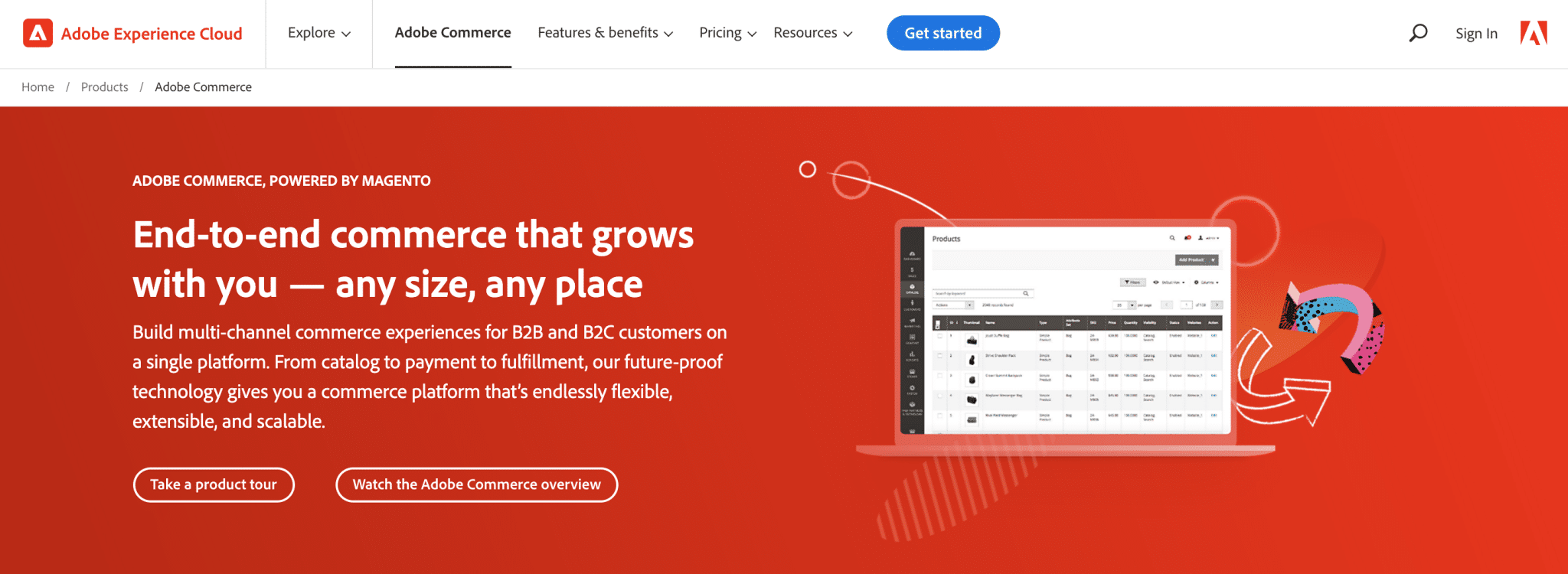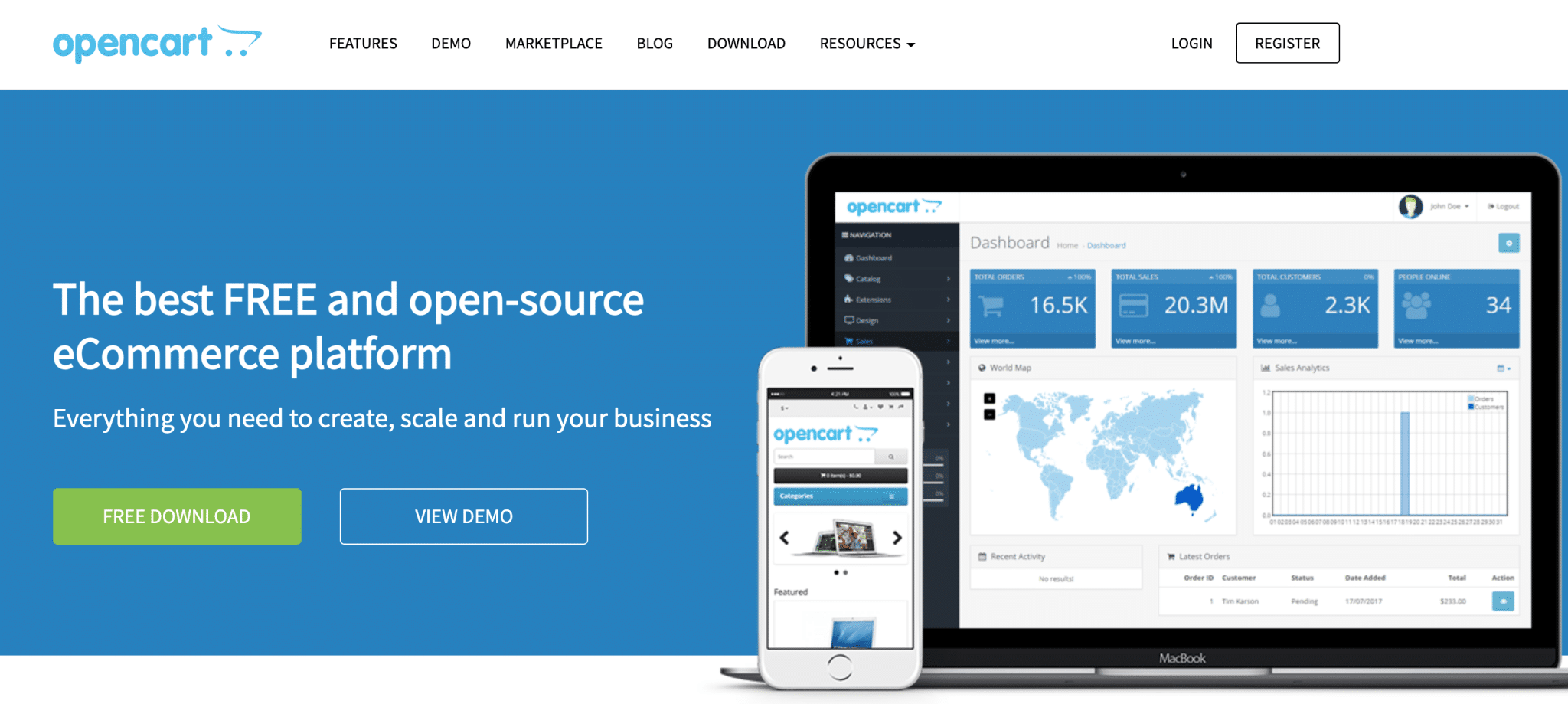You surely know the following expression: “see the forest for the trees”. We can find various fields of application, and you can see that it works in the field of ecommerce.
Yes, in ecommerce, there is WooCommerce (the tree) and the others (the forest). It must be said that the famous ecommerce plugin takes a lot of space.

Unavoidable, it is simply the most used solution across the planet to design an online store.
However, it is not the only ecommerce plugin on the market. Not to mention the other tools at your disposal, if we go outside the WordPress ecosystem.
If WooCommerce is firmly rooted in the landscape and makes quite a lot of shade to the competition, it does not always represent the ideal solution to create an ecommerce site.
In order to help you see more clearly in this dense landscape, this article presents 12 WooCommerce alternatives, with a perspective on each one: are they suitable for you?
Overview
WooCommerce, a flagship ecommerce plugin with multiple benefits…
An ecommerce plugin really essential
A quick reminder, before unfolding the thread of this article. Active since September 2011, WooCommerce is an ecommerce plugin that turns your WordPress site into an online store.
Since 2015, it has been developed and managed by Automattic, the company behind WordPress.com, and a major contributor to WordPress.org.
At the time of writing – and it’s unlikely to change when you read this – WooCommerce is simply a must-have in the ecommerce world.
In a decade, it has established itself as the figurehead of ecommerce solutions. On WordPress, but not only, as shown by these eloquent statistics:
- 8.8% of the world’s websites run on WooCommerce making it the most widely used ecommerce solution worldwide. For comparison, WordPress (both
.comand.orgversions) powers 43% of the world’s web at the time of publishing this article. - WooCommerce is one of the 9 plugins in the official WordPress directory that have 5M+ million active installations. The famous ecommerce plugin would precisely run on 5.1 million sites across the planet.
- Almost a third of ecommerce sites (27%) use WooCommerce (among the million sites that receive the most traffic), compared to 21% for example for Shopify (source: BuiltWith).
- 93.7% of online stores designed with WordPress use WooCommerce (source: Websitebuilder).
As you can see, WooCommerce is a force to be reckoned with in its market. Its growth also got a big boost with the start of the Covid-19 pandemic in early 2020, as many people turned to the ecommerce plugin to start selling online (this observation also applies to other competing solutions).
Some major plugins in the WordPress ecosystem, such as the Elementor page builder, have chosen to capitalize on the trend.
The famous page builder has been focusing on ecommerce for several months, frequently releasing new options to help its users customize WooCommerce stores without coding.
Why such a success?
If the numbers say a lot about the power of WooCommerce, they also call for a question: what are the reasons for the success of this ecommerce plugin?
We can mention several ones:
- Its flexibility. First of all, WooCommerce allows you to create any type of online store, regardless of its size. Secondly, you can sell any type of products with it (physical, digital, memberships, etc.).
- Its cost. The ecommerce plugin is free, although you will probably have to spend some money if you want to get one or more extensions to make it even more complete.
- Its ecosystem. There are thousands of themes and plugins dedicated specifically to the ecommerce plugin created by Woo Themes. You will find for example more than 1,300 themes dedicated to it on the official directory, and extensions to meet many needs (delivery, payment, billing, marketing, social networks etc.).
- Its compatibility with themes and plugins. Since it is a must-have, many theme and plugin creators try to be compatible with it. You have seen it with Elementor for example, which I mentioned a few lines above.
- Its open-source aspect. This allows you, among other things, to keep control of all the parameters of your site, which competing solutions do not always allow (we’ll come back to this).
So, does WooCommerce seduce you?
And for a transversal and global vision of WooCommerce, you can also complete your learning with the reading of this content, on the WPMarmite blog.
That’s it, we stop here? Well, not really. While WooCommerce is a great solution for setting up an online store, you will now see that it does have some limitations.
Well, nobody is perfect. 😉
…with some drawbacks
When you start with it, WooCommerce is still not easy, let’s face it:
- A learning curve is necessary to tame and understand its different menus. Even if it is used on your WordPress interface, which you are used to, WooCommerce has its own specificities.
- You don’t have a direct customer service (support) at your disposal. So you have to figure it out by yourself when you get stuck, by browsing tutorials and/or poking around on dedicated forums.
- As with any WordPress site, you must manage the maintenance of your online store, i.e. ensure the updates and security of your online store. As with any WordPress site, in short.
- It can slow down your back-office, which is never very pleasant. So you need to know the best practices to avoid overloading it.
Beyond these few reasons, WooCommerce may simply not be the right solution for you, depending on your technical knowledge, your goals and your needs.
To understand who revolves around it, here is an overview of ecommerce plugins (at least 10,000 active installations) and alternatives to WooCommerce. I present you 12 of them, divided into three categories.
The alternative ecommerce plugins to WooCommerce
Easy Digital Downloads

Active installations: 50K+
Easy Digital Downloads is a freemium ecommerce plugin for selling digital products (ebooks, software, documents, videos, photos, etc.).
Created by the American developer Pippin Williamson and his company Sandhills Development, it was acquired in September 2021 by Awesome Motive, the company of Syed Balkhi who is behind plugins such as Optin Monster, WPForms, Smash Balloon, etc.
What are the advantages of the Easy Digital Downloads ecommerce plugin?
- A ready to use shopping cart system.
- Integration with different payment gateways like Stripe, PayPal, Google Pay and Apple Pay.
- The possibility to create coupon codes and protect the download of certain files, for example after a certain time or several attempts.
- Integration with a vast ecosystem: Easy Digital Downloads integrates with many tools and plugins (Mailchimp, Dropbox, Slack, Zapier, etc.). It is also backed by a community of developers, which offers over a hundred themes and dedicated plugins.
- Access to sales statistics and your customers’ purchase history.
How much does Easy Digital Downloads cost?
Easy Digital Downloads has a free version, available on the official WordPress directory.
However, to get the most out of it, the use of one of its pro licenses will surely be necessary (starting at $99.50 for a use on 1 site), or the purchase of add-ons to meet a more specific need.
To be in conformity with the European regulation concerning the VAT on digital products, you will also need a plugin such as EU VAT for Easy Digital Downloads (€89 i.e. ± $101 per year for a site).
Easy Digital Downloads, for whom?
If you want to sell only digital products, Easy Digital Downloads can be an alternative solution to WooCommerce.
Its interface will be less busy and more intuitive, making it easier to learn. You can also sell physical products with it, using its add-ons.
But in this case, WooCommerce will be more powerful and flexible.
Download Easy Digital Downloads:
MemberPress

MemberPress is a premium plugin that allows you to create a membership site, with the possibility of selling memberships and digital products, in particular.
What are the advantages of MemberPress?
- MemberPress claims to be the easiest to use membership creation tool on the market.
- The plugin allows you to fine-tune access rules to your articles, pages, videos, products, etc., based on the type of membership your members have.
- Integration with many third-party solutions.
- Possibility to create a dedicated forum for your members, to encourage interaction.
- Content dripping is possible (access to a second piece of content only after the first piece of content has been uploaded), as well as the provision of content with an expiration date.
- MemberPress can also be used as an LMS (Learning Management System) platform to manage educational content.
How much does MemberPress cost?
To take advantage of MemberPress’ features, you’ll need to pay a minimum of $179/year, for use on 1 site. And even then, this license does not give you access to all of the plugin’s options.
As you can see, the investment is quite substantial. However, it’s a bit cheaper than what WooCommerce offers, with its WooCommerce Memberships extension ($199/year), which also allows you to create a members’ area, but not a learning platform (LMS).
MemberPress, for whom?
MemberPress is mainly intended for users who want to create a members’ area on their WordPress site. It does a very good job in this area, but will be limited compared to WooCommerce if you want to create a more traditional online store (with physical and digital products).
Note that if you want to create a members area, the freemium plugin Paid Memberships Pro is more affordable to start with.
Gravity Forms

Gravity Forms (affiliate link) is a premium plugin that allows you to design contact forms. Yes, but what does it have to do with an ecommerce solution?
Well, if I talk about it here, it’s because Gravity Forms is so powerful that it allows you to create a small order form, which will be useful if you want to sell a product, for example.
What are the advantages of Gravity Forms?
Gravity Forms allows you to add multiple fields (standard, advanced, items, prices, etc.), or to create conditional logics (some fields will be displayed only if certain conditions are met).
I won’t develop more here. You can find our tutorial on how to use this plugin on the blog.
How much does Gravity Forms cost?
Gravity Forms is available from $59/year for a use on 1 site.
However, if you want to use Gravity Forms as an ecommerce system, you will have to buy the Elite license ($259/year).
This license allows you to use payment gateway add-ons such as Paypal or Stripe.
Gravity Forms, for whom?
Don’t get me wrong: despite its power, Gravity Forms is not an ecommerce plugin, and it will never replace a complete tool like WooCommerce to create a robust online store.
If you are used to using it, it can be used for a very specific need (e.g. creating an order form).
After having examined several essential ecommerce plugins, let’s move on to a second family of WooCommerce alternatives: hosted tools.
Note also that solutions like Stripe and Paypal allow you to add a simple payment button on your WordPress site, which can already be enough if you want to sell a single product or service, for example. Several plugins allow you to link these two payment gateways to WordPress, not to mention that they also integrate with WooCommerce.
In the same vein, the WP Simple Pay plugin might also interest you, and this one for PayPal.
Hosted solutions as WooCommerce alternatives
Ecwid

Ecwid is a platform that allows you to create an online store, while offering an integration with WordPress using a dedicated ecommerce plugin: Ecwid Ecommerce Shopping Cart.
What are the advantages of Ecwid?
- Ecwid aims to help you design an eshop “from scratch in just five minutes, with simple and customizable design tools” without installing any software.
- You can sell on social media (Facebook, Instagram, Amazon, Google) from your Ecwid dashboard.
- Ecwid supports all WordPress themes and hosting.
- The tool takes care of maintenance, automatically updating your store, or offering unlimited backups.
- Shipping, payment and taxes are automated.
- Ecwid can automatically export your WooCommerce products.
How much does Ecwid cost?
While the WordPress plugin is free, its use is very limited. You can only add a maximum of 10 products.
Paid plans start at $15/month, but again, the number of products you can add is very limited (100 at most). For unlimited use, you must switch to the Unlimited plan ($99/month).
Ecwid, for whom?
Ecwid is primarily intended for people who want to create an online store very quickly, without getting bogged down with the technical side. On the other hand, I do not recommend it to people who want to create a store with many products.
If you don’t want to be bound hand and foot, you’ll have to get your wallet out ($1,200/year).
BigCommerce

BigCommerce looks like “the most versatile solution on the market for innovative ecommerce“.
It’s a Saas (Software as a Service) platform that works in headless, meaning that when you connect it to WordPress, it takes care of the back-end (basically, the ecommerce administration of the site such as product management, payment and logistics), while WordPress manages the front-end (the visible content online).
There is a dedicated WordPress ecommerce plugin, BigCommerce for WordPress, which facilitates the integration between the two platforms.
What are the advantages of BigCommerce?
- A drag and drop editor to create your pages without coding.
- Customizable themes.
- Built-in features galore for SEO, faceted navigation, and site speed, to name a few.
- Multiple store management: find all the products of your stores on the same interface, with a single login.
- No transaction fees on payments.
How much does BigCommerce cost?
BigCommerce offers 3 price plans, ranging from $29.95/month to $299.95/month. However, each plan is limited in the amount of sales you will make online.
The Standard plan ($29.95/month), for example, doesn’t allow you to sell more than $50,000 over the past 12 months. To break any limit, you will have to start on the Enterprise license (rates not disclosed).
BigCommerce, for whom?
BigCommerce is a growing and very powerful solution, which will appeal to technology enthusiasts in particular headless.
Because of its multiple options, it is primarily intended for stores containing many products, much less for small businesses.
Shopify

Launched in 2006, Shopify is a paid online ecommerce platform that operates in SaaS (software as a service) mode.
It is a very popular solution: according to its data, Shopify is used by more than a million businesses.
It is also the main competitor of WooCommerce, on the million ecommerce sites that receive the most traffic. Shopify would be used on 20% of them, against 28% for WooCommerce.
What are the advantages of Shopify?
- Shopify has made a name for itself because of its simplicity of use: it is primarily aimed at non-technical profiles. It is easy and quick to install.
- The tool takes care of almost everything for you: domain name, security, maintenance, marketing, etc.
- A drag-and-drop interface, with real-time visualization of changes.
- Shopify is known for its speed, as it hosts its sites on its own servers.
- 24/7 support via email, chat or phone if you subscribe to one of the paid plans.
- Optimization for mobile commerce, with a shopping cart adapted to this type of device.
- Abandoned cart recovery option and integration with over 100 payment gateways.
How much does Shopify cost?
Shopify offers 3 packages: Basic ($29/month), Shopify ($79/month) and Advanced ($299/month).
The higher the license, the more employee accounts you can create (members with access to the admin interface), and the lower the fees on each transaction.
Shopify, for whom?
Shopify is perfectly suited for beginners who do not want to take care of all the technical aspects of their online store (security, maintenance, hosting, updates, etc.). It is therefore a reliable alternative to WooCommerce.
On the other hand, despite these strengths, Shopify does not offer as many customization options as WooCommerce, and is not as flexible. If you want to have full control over your online store, WooCommerce will be more suitable (provided you have some technical background).
To get an even better idea of the differences between the two solutions, check out our comparison of the two.
Wix eCommerce

If Shopify is specifically dedicated to ecommerce, Wix is a hosted solution that allows you to create both a showcase site and an online store, thanks to its ecommerce features.
As it says on its homepage, with Wix, you can “Create your online store from the ground up with powerful Wix tools that help you build a successful business online”.
Like any SaaS solution, it can only be used online, from a dedicated website where the user logs in.
Founded in 2006, Wix claims more than 200 million users. Even if it is very popular, it is still far from the figures of WordPress and WooCommerce. According to W3techs, it runs on 1.9% of sites worldwide (compared to 8.7% for WooCommerce, and 43% for WordPress).
What are the advantages of Wix eCommerce?
- Wix is quick and easy to install, especially if you use its artificial intelligence process called Wix ADI (Artificial Design Intelligence). It will take care of setting up your custom website, with custom text and images.
- Wix takes care of the hosting of your website, its updates, its security, etc.
- Wix is very easy to use, especially thanks to its visual drag and drop interface.
- You can sell physical and digital products with Wix eCommerce.
- A relatively large offer of templates (more than 500), if you compare it to other hosted solutions.
- Possibility to create subscriptions to receive regular payments.
How much does Wix cost?
If Wix can be used for free (with serious limitations) to launch a showcase site, you will have no choice but to pay to receive online payments.
Wix offers 3 eCommerce packages, from $23/month for the most accessible, to $49/month for the most expensive.
Wix eCommerce, for whom ?
Wix eCommerce is primarily intended for users of… Wix who are satisfied with the platform and do not want to change.
If you are a fan of hosted solutions and want a tool designed for ecommerce, Shopify seems more complete and appropriate.
Anyway, Wix eCommerce can be suitable for a small business that wants to start, provided that it does not have too many products, because the inventory management is less intuitive than on WooCommerce.
The latter will also be much more complete, if you couple it with essential extensions.
On the other hand, Wix is not open source, which means that you don’t have access to its source code to modify it.
Squarespace

In the same vein as Wix, here is one of its main competitors: Squarespace, which also offers an option to set up and customize an online store.
Wix and Squarespace are in the same category as WordPress.com, the hosted solution offered by Automattic.
Having trouble understanding the differences between WordPress.com and WordPress.org (used by WPMarmite)? Since it can sometimes be confusing, we explain to you how these two WordPress have nothing to do with each other right here.
What are the advantages of Squarespace?
- As with Wix and Shopify, Squarespace has focused on simplicity of use. Setting up an online store is just a few clicks away, and Squarespace takes care of security, maintenance, hosting, etc.
- Unlimited addition of products and creation of enriched product sheets (videos, images, suggestions, etc.).
- Integration with Stripe and PayPal payment gateways.
- Possibility to send satisfaction surveys to your customers and post reviews to reinforce social proof.
- Possibility to sell physical, digital and subscription products.
- Personalized 24-hour support via email, instant messaging or by participating in a live webinar.
- Templates are clean and simple.
How much does Squarespace cost?
Squarespace’s ecommerce functionality is available with a Business license ($18/month). However, only the “Advanced Commerce” license gives access to the most advanced options, such as the recovery of abandoned carts, or the sale of subscriptions.
Squarespace, for whom?
Same notes as for Wix or Shopify: Squarespace is mostly dedicated to novices who don’t want to be bothered with the technical aspects and maintenance of their site.
If you already use this solution for your website and it suits you, go for it.
If you’re starting from scratch and want to have control over every aspect of your online store, you’ll want WooCommerce.
Gumroad

Gumroad is an ecommerce platform designed to help you sell digital products (books, subscriptions, training).
A bit like Easy Digital Downloads, except that it has its own existence, outside of WordPress.
What are the advantages of Gumroad?
- You can use Gumroad to create your online store, or use its own payment platform to integrate it into your site.
- It is possible to sell products by subscription.
- Access to analytical data on the sales made.
- Possibility to send emails (automated or not) to communicate with your audience.
How much does Gumroad cost?
Gumroad is free, in the sense that you do not have to pay anything to use it. However, it does charge a fee on your sales, which decreases as your sales increase.
For example, Gumroad charges a 9% fee on sales (+30 cents per transaction) when your revenue on the platform is between $0 and $1,000. They are 7% (+ 30 cents per transaction) when you generate between $1,000 and $10,000.
Gumroad, for whom?
Gumroad’s core target is primarily people who want to sell digital products.
We have finished with the presentation of hosted solutions. Let’s now move on to the open source alternatives to WooCommerce.
As with WordPress.org, you can view and modify the code of these solutions as you wish, and install them on the hosting server of your choice.
Open source alternatives to WooCommerce
PrestaShop

PrestaShop is an ecommerce software that will help you create an online store.
Created in 2007, PrestaShop would propel more than 300,000 ecommerce sites in the world, for a total of 17 billion euros of online sales generated.
What are the advantages of PrestaShop?
- An impressive number of features (more than 600), as well as the presence of more than 5,000 modules and themes.
- Flexibility: the open source aspect of PrestaShop makes it malleable. You can customize it to your liking.
- PrestaShop is free and can stay free: you are free to pay to add new features, or not.
- The tool is translated into more than 75 languages.
- You can finely manage all the essential components of an online store: products, stocks, deliveries, payment methods, SEO, etc.
- A very large community: more than a million members, more than 1,000 contributors to develop its code, and 250 partner agencies.
How much does PrestaShop cost?
Prestashop is free: you can download and install the software on your server at no cost.
Note that PrestaShop offers a Starter Pack (a site with the essential modules) for those who do not want to start from scratch (at €435.99 i.e. ± $498).
Finally, more than 5,000 modules, themes and services are offered for sale – some are free – on the official PrestaShop marketplace. Prices vary depending on the module, but on average, you should expect to pay at least €60 i.e. ± $68 to get one.
PrestaShop, for whom?
PrestaShop is a reliable and robust alternative to WooCommerce, which is perfect for online stores hosting many products.
As with WooCommerce, a learning curve will be necessary to master the tool. Having used both, I find PrestaShop’s back office more complex to learn than WooCommerce’s.
If you already use WordPress and want to create an online store, WooCommerce will surely be more adapted, especially because you will already be familiar with the WordPress interface.
Magento

Magento is an open source ecommerce platform owned by Adobe (the company behind Photoshop, Illustrator, Premiere Pro, etc.).
This historical CMS (Content Management System), launched in 2008, is still losing speed. It represents only 1% of the CMS market share, against 65.2% for WordPress and 6.6% for Shopify, for example (source: W3Techs).
It currently exists in two versions: “Magento Open Source”, the most widely used version of the CMS, and “Adobe Commerce”, notably based on the cloud.
What are the advantages of Magento?
- The open source solution is free.
- It is very flexible and can be adapted to the creation of all types of stores… provided you know how to handle it.
- Since Magento is a solution made for ecommerce, it offers the appropriate functionalities (stock and order management, customer service, payments, delivery, marketing, etc.).
- Magento comes with a WYSIWYG editor (What You See Is What You Get): you can see your changes in real time when creating your content.
- A large community is backed by the CMS, with nearly 250,000 companies using Magento.
How much does Magento cost?
The open source version of Magento is free. However, as with WooCommerce, you will surely have additional costs to bear (hosting, domain name, etc.), especially if you decide to use one or more plugins.
The prices of the latter vary, but they are generally found between $100 and $300 per unit.
As for the prices of Adobe Commerce, they depend on the amount of your annual sales.
Magento, for whom?
Magento, especially in its open source format, is a software primarily intended for technicians and relatively advanced users.
Its handling is complex, which is why I do not recommend it to a beginner. On the other hand, due to its power and flexibility, let’s emphasize that it is very suitable for online stores selling thousands of products.
Download Magento:
OpenCart

OpenCart is one of the oldest alternatives to WooCommerce on the market.
Originally launched in 1999, OpenCart got off to a rocky start with little activity, reports Wikipedia, before being relaunched in 2006 by the so-called Daniel Kerr. Since then, OpenCart is still here!
As it states on its official website, with OpenCart, there are “No monthly fees, no catches; just an effective and customizable platform for your new ecommerce store. Add products and you’re ready to start accepting orders”.
What are the benefits of OpenCart?
- OpenCart software is free.
- You can create an unlimited number of products and categories: OpenCart is suitable for both small and large stores.
- Its multi-reference marketplace with over 13,000 modules and themes.
- The possibility to manage multiple stores from the same interface, each with its own features.
- The functionality to backup and restore your ecommerce site.
- A dashboard with a lot of information about sales, orders, analytical data, etc.
- The presence of basic options (adding products, inventory management, payment gateways, delivery, coupons, etc.).
How much does OpenCart cost?
OpenCart is free to download and use. However, you must pay for hosting and a domain name every year, at least.
Not to mention possible extensions (called modules), whose prices start on average around $20.
OpenCart, for whom?
Despite an intuitive dashboard, OpenCart remains a solution a little more technical to master than WooCommerce.
Even if many modules are offered, you will need a solid knowledge of PHP (the language in which the platform is coded) if you want to customize it finely.
Which ecommerce plugin to choose?
As you may have noticed, there are multiple ecommerce plugins and other WooCommerce alternatives on the market.
In the middle of all this, it is not easy to find your way around, is it? So, which tool should you choose?
To answer this question, you must first consider several factors:
- Your needs: do you want to create a store with many products? Do you want to sell only a certain type of product (e.g. digital products)?
- Your technical capabilities: do you want to get your hands dirty? Are you ready to take care of the maintenance, the security or the hosting of your ecommerce site?
- The need for individual help: in this case, the presence of a user assistance will be required.
- The ecosystem that surrounds the tool you want to adopt. The existence of a marketplace with numerous themes and plugins, as well as the presence of an active community, especially of developers and partners, is a real plus.
- Your budget. Don’t forget that even if a software is free at the beginning, there are additional costs to take into account (e.g.:purchase of extensions). It is important to set a budget that you do not exceed from the start!
Once you have taken stock of all this, you will see much more clearly. 😉
Now you just have to choose the right tool.
The best ecommerce plugin does not exist. The right tool is above all a tool adapted to your needs.
Nevertheless, here are some tips to help you decide:
- If you already use WordPress, WooCommerce will be an excellent choice, whatever the size of the store you want to set up. Flexible, powerful and backed by a huge community that is constantly evolving and improving, WooCommerce remains a must-have tool. However, note that you will have to invest some time to understand how it works and make the most of it.
- If you use WordPress and only want to sell digital products, Easy Digital Downloads can be a very interesting solution.
- If you don’t want to bother with technology and don’t use WordPress (and don’t plan to), Shopify should suit you.
- If you are a tech-savvy person and don’t want to rely on WordPress to create your eshop, alternatives to WooCommerce such as PrestaShop or BigCommerce have their strengths.
On the WPMarmite side, our choice is clear: we love WooCommerce!
What about you, what’s your opinion on it? Share your feedback in the comments.

Receive the next posts for free and access exclusive resources. More than 20,000 people have done it, why not you?






Continue reading
Articles posted in WordPress TipsThe ultimage guide to WordPress maintenance
Do you want to be hacked? Do you want to have a slow site like a turtle? Do you want to be unable to restore your site? If you answer “yes,” you are a kamikaze. A little birdie tells me…
Gutenberg vs. page builder: Which to choose?
On my left, Gutenberg. On my right, a page builder. In the center, you. Gutenberg draws you in. He holds out his arms. And yet no: This page builder still has a few choice features that make you love it….
16 ways to make money on the internet with WordPress in 2024
“How to make money on the internet with WordPress? Here we go, another clickbait title!” I can hear you from here, dear readers. Let me be clear: far be it from me to fall into the trend of those websites…